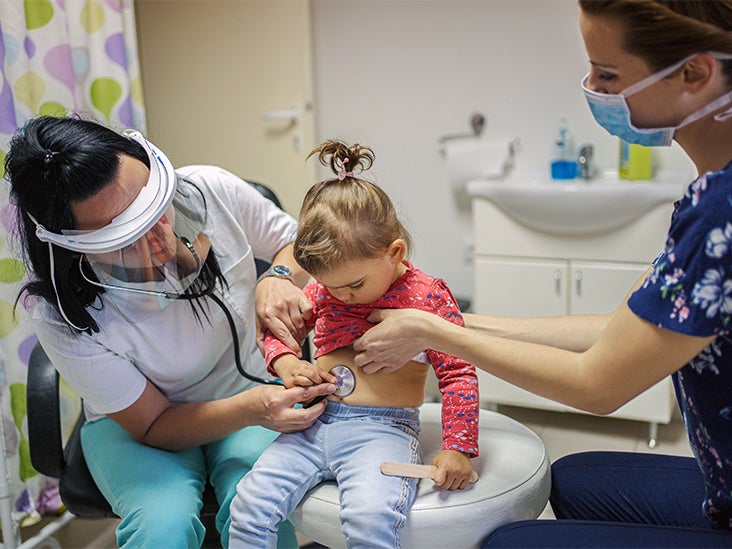
Breast cancer is one of the most common types of cancer diagnosed in America. While you probably associate this disease with adults, the truth is that children have breasts, too.
Fortunately, most breast lumps in children are benign tumors that don’t cause harm and aren’t dangerous. When cancer develops in the breast in children, radiation therapy and surgery to remove the tumor might be required.
Breast cancer occurs when cancer cells grow in breast tissue. The disease is most commonly found in women. This risk of breast cancer increases with age, with the highest risk between ages 70 and 74, according to the Centers for Disease Control and Prevention (CDC).
However, breast cancer can also be found in men and children.
In fact, according to the American Cancer Society, about 2,650 American men are diagnosed with breast cancer every year. Cases in children are rarer but not impossible.
Often, when children have tumors in their breast tissue, the tumors aren’t cancerous. Instead, they’re what is known as fibroadenomas.
Fibroadenomas are benign and don’t cause symptoms. Children with fibroadenomas still need to be monitored because, rarely, they can grow and become cancerous.
Breast cancer in children is rare, and many of the symptoms can be caused by other, less serious conditions.
However, if your child has any of the following symptoms, they should be examined by a medical professional as soon as possible:
- a lump in the underarms, around the nipples, or anywhere in the breast area
- a change to the shape of the breast area that’s not associated with puberty or weight gain
- skin at or around the breast that looks uneven, dimpled, or puckered
- skin at or around the breast that is red, scaly, itchy, or swollen
- a nipple that has turned inward
- blood or other fluids coming from the nipple
Breast cancer in children is caused by cancer cells in the breast. The causes can vary and are often unknown.
In many cases, breast cancer in children is a result of another cancer that has spread to the breast tissue. This can happen as a result of several cancers more commonly found in children including:
If one of these cancers spreads to a child’s breast tissue, it can result in cancer of the breast.
Many children who develop breast cancer have a history of another cancer, but that’s not always the case. While there’s no way to 100 percent predict breast cancer in children, there are a few known risk factors.
These risk factors include:
- previous radiation treatment to the chest or breast for another cancer
- a parent or sibling who has previously had breast cancer
- an inherited change to BRCA1, BRCA2, or another gene that can cause breast cancer
The treatment for cancer of the breast in children varies and will depend on the tumor or type of cancer.
Children with benign fibroadenomas will not usually need treatment. Instead, they’ll be carefully monitored for changes that might indicate concern, such as changes in size or characteristics of a mass. In many cases, the fibroadenomas will disappear without any treatment at all.
Children with malignant breast cancer will need treatment. They’ll receive care from a pediatric oncology team.
Treatments normally include:
- radiation therapy to target and kill the cancer cells and stop the growth of new cancer cells
- surgery to remove the tumor
New therapies, including targeted drug therapies to attack cancer cells without harming other cells in the body, are also an option. Treatment will also depend on the child’s overall health and if other cancers are present.
The pediatric oncology team will help develop the appropriate plan for each child.
Most children with breast tumors have fibroadenomas. Often, these disappear on their own. Fibroadenomas aren’t harmful or dangerous unless they mutate into cancerous tumors — which is rare, especially in children.
A child or teen with a fibroadenoma will be watched to ensure it remains harmless. Doctors might do a biopsy of the tissue to ensure it is benign.
For children with malignant breast cancer, the outlook can vary.
Just like most other types of cancer, controlling the spread will make a huge difference in the outcome. The goal is always for tumors to be treated or removed without spreading.
In general, the outlook for children with all cancer types is getting steadily better.
As of 2021, there is an 84 percent 5-year survival rate for children diagnosed with any type of cancer. While there aren’t statistics on the exact survival rates of children with cancer of the breast, the 5-year survival rate for breast cancer in adult women is 90 percent.
The faster children get treatment for cancer, the better the odds will be. Cancer that hasn’t spread is always easier to treat and cure.
So, if your child has any symptoms that could be breast cancer, ask your medical provider about it as soon as you can.
Breast cancer in children is very rare but it can happen. When children do have tumors in their breast tissue, they’re normally nonharmful tumors called fibroadenomas.
A child with fibroadenomas will need to be monitored but won’t need any treatments.
Occasionally, children will have more malignant breast tumors. In this case, radiation treatments or surgery will be needed.
"breast" - Google News
February 26, 2021 at 02:22AM
https://ift.tt/3sqpsAm
Breast Cancer in Children: What You Need to Know - Healthline
"breast" - Google News
https://ift.tt/2ImtPYC
https://ift.tt/2Wle22m
Bagikan Berita Ini














0 Response to "Breast Cancer in Children: What You Need to Know - Healthline"
Post a Comment